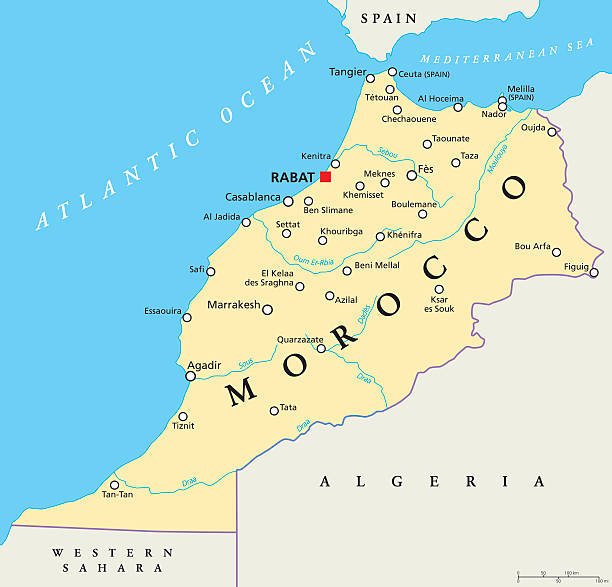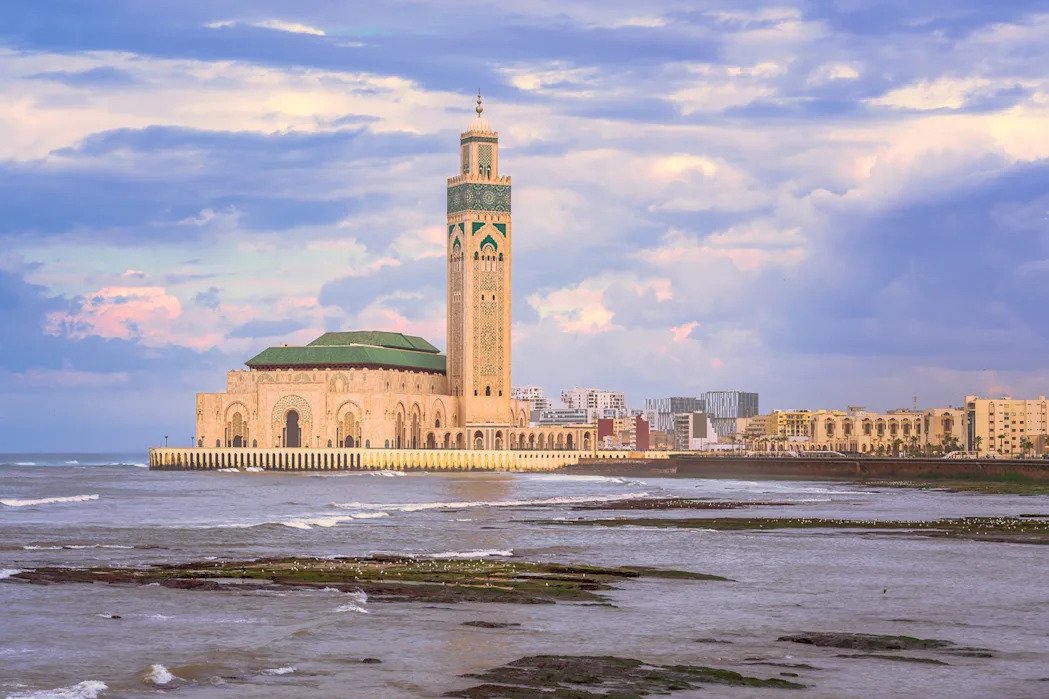Discover why Casablanca is Morocco’s best city for architecture. Casablanca blends Islamic tradition, French colonial Art Deco, and sleek modernism into one breathtaking urban landscape. From the monumental Hassan II Mosque to Art Deco boulevards and futuristic skyscrapers, Casablanca offers the richest architectural diversity in Morocco. This guide explores why Casablanca is the ultimate city for architecture lovers—and how to experience it fully.
Why Casablanca Outshines Other Moroccan Cities
When people think of Moroccan architecture, Marrakesh’s red walls or Fez’s medieval medina often come to mind. Yet Casablanca—the country’s largest city—outpaces them all when it comes to architectural diversity, preservation, and grandeur. Casablanca is not just Morocco’s economic capital; it is a living open-air museum, where Islamic, Art Deco, and contemporary styles coexist harmoniously.
Unlike its romanticized Hollywood version, the real Casablanca is an energetic, modern city built on a centuries-long story of cultural fusion. Its architecture is both monumental and accessible, a visual timeline of Morocco’s evolution.
1. What makes Casablanca’s architecture uniquely compelling?
Casablanca is Morocco’s only city where heritage meets modernity on every street corner. Historically called Anfa, the city was reshaped during the French Protectorate (1912–1956), when urban planners transformed it into a “model city.” They designed wide boulevards, civic squares, and residential areas that fused French Art Deco with Moroccan design.
Examples include:
- Wilaya Building (City Hall) – Designed by French architect Marius Boyer, blending a European clock tower with Moroccan zellij tiles.
- Maret Building (1932) – A curved Art Deco façade crowned by a tiled dome, one of the city’s most iconic structures.
This seamless integration of Islamic geometry and European lines makes Casablanca stand out. It is a city of contrasts where minarets, stained-glass windows, marble lobbies, and zellij mosaics all tell the same story of identity.
2. What iconic landmarks illustrate Casablanca’s architectural richness?
Casablanca is dotted with landmarks that represent every era of its history:
- Hassan II Mosque – The city’s crown jewel, with the tallest minaret in Africa, built partly on the Atlantic Ocean. Its prayer hall can hold 25,000 worshippers.
- Casablanca Twin Center – Twin skyscrapers designed by Ricardo Bofill, symbolizing modern Morocco.
- Al-Mohammadi Mosque – A 1930s Neo-Moroccan mosque inspired by Marrakesh’s Kutubiyya Mosque.
- Place Mohammed V (Square) – A civic masterpiece framed by colonial government buildings in Art Deco style.
- Royal Palace of Casablanca – A symbol of power and architectural harmony, although closed to the public.
- Cinemas like Rialto & Vox – Landmarks of Casablanca’s “Golden Age” of Art Deco.
Each of these sites illustrates Casablanca’s status as Morocco’s architectural capital.
3. How does the old blend with the new in Casablanca?
Casablanca’s charm lies in its ability to preserve the past while embracing the future.
- Preservation Efforts: Groups like Casamémoire lobby to protect Art Deco heritage, working toward UNESCO World Heritage status.
- Adaptive Reuse: Old villas are converted into art galleries, boutique hotels, or fine-dining restaurants—like the Shell Building turned into the Imperial Hotel & Spa.
- Urban Renewal: The port area and La Corniche have been redeveloped into tourist-friendly promenades while maintaining architectural identity.
Few cities in Morocco achieve this balance of authentic heritage and modern lifestyle so effectively.
4. What emotional and cultural resonance does this architecture offer?
Casablanca’s architecture does more than please the eye—it connects people emotionally.
- The Hassan II Mosque, perched dramatically on the Atlantic, evokes spiritual awe.
- The Art Deco cinemas recall the glamour of the 1930s, when Casablanca was dubbed the “Hollywood of Morocco.”
- Civic spaces like Mohammed V Square express national identity—where Moroccan motifs meet colonial ambition.
As historian Jean-Louis Cohen once said, “Casablanca was the most creative of all the cities of France’s empire.” This creativity remains palpable today.
5. How can readers experience Casablanca’s architecture firsthand?
If you’re planning a trip, here’s how to explore Casablanca’s built environment:
- Start at Hassan II Mosque – Non-Muslims can join guided tours.
- Stroll along Boulevard Mohammed V – Admire Art Deco façades, Rialto Cinema, and cafés.
- Explore Place Mohammed V – See the Wilaya, Palace of Justice, and Bank of Morocco.
- Visit Habous Quarter – A French “new medina” designed in traditional Moroccan style.
- Stay in Heritage Hotels – Book at Imperial Casablanca Hotel & Spa or Royal Mansour Casablanca to immerse in architectural history.
These experiences bring Casablanca’s architecture alive for visitors.

6. FAQ: Questions Americans Ask About Casablanca’s Architecture
Q1: Why is Casablanca considered Morocco’s architecture capital?
Casablanca uniquely fuses Islamic tradition, French colonial heritage, and modern design. From the Hassan II Mosque to Art Deco boulevards and futuristic skyscrapers, its range is unmatched by any other Moroccan city.
Q2: What styles are dominant in Casablanca’s architecture?
Neo-Mauresque, Art Deco, Art Nouveau, Modernist, Islamic, and postmodern skyscraper styles all coexist—making it a global design fusion zone.
Q3: Can non-Muslims visit Moroccan mosques?
Most mosques are closed to non-Muslims. However, Casablanca’s Hassan II Mosque is an exception, offering guided tours in multiple languages.
Q4: What’s the best way to explore the city’s architecture?
Join a Casamémoire architecture tour or explore independently on foot, especially along Boulevard Mohammed V and in the Habous Quarter.
Q5: How much time should I allocate for architecture-focused travel?
Three to four days is ideal: one day for Hassan II and the medina, one for colonial areas, and one for modern landmarks.
Q6: Are there guided routes specifically for architecture lovers?
Yes, Casamémoire tours guide visitors through Casablanca’s Art Deco and Neo-Moorish landmarks.
Q7: Which sites combine shopping, design, and views?
The Casablanca Twin Center offers shopping, offices, and restaurants with panoramic city views.
Q8: What else does the Old Medina offer, architecturally?
It showcases traditional Moroccan urbanism, contrasting sharply with Casablanca’s modern skyline.
Q9: Which hotels best reflect local architecture in their design?
- Imperial Casablanca Hotel & Spa – A converted 1930s Shell building.
- Royal Mansour Casablanca – An Art Deco skyscraper turned luxury hotel.
Q10: How is Casablanca preserving its architectural legacy?
Through restoration projects, heritage laws, and international campaigns for UNESCO recognition.
Q11: Where is the Real Casablanca located?
Casablanca is located on Morocco’s Atlantic Ocean coast, southwest of Rabat. Unlike the Hollywood film, the real city is a modern metropolis with 4 million residents, international trade hubs, and world-class architecture. Travelers can fly into Mohammed V Airport and explore iconic landmarks like Hassan II Mosque, La Corniche, and Place Mohammed V.
Q12: What is the famous square in Casablanca?
Place Mohammed V is the city’s most famous square. Designed under the French Protectorate, it is surrounded by Art Deco and Neo-Moorish buildings such as the Wilaya, Palace of Justice, and Bank of Morocco. It is the symbolic and architectural heart of Casablanca, much like Trafalgar Square in London.
Q13: Casablanca Universe Map – Every Known Location Ranked
Casablanca can be seen as a “universe map,” with each district offering unique architecture:
- Hassan II Mosque
- Place Mohammed V
- Habous Quarter
- Casablanca Twin Center
- Old Medina
- Boulevard Mohammed V
- Royal Palace
- La Corniche & Ain Diab
- Parc de la Ligue Arabe
- Rialto & Vox Cinemas
Each neighborhood is a different level in the Casablanca experience, from spiritual to modern to leisure.
Final Thoughts
Casablanca is not just a backdrop for a classic film—it is Morocco’s ultimate architecture city, where East meets West and tradition blends with modernity. Whether you’re walking through the Art Deco boulevards, marveling at Hassan II Mosque, or enjoying seaside views along La Corniche, every part of Casablanca tells a story.
For travelers, students of architecture, and cultural explorers alike, Casablanca is a universe of design waiting to be discovered.
